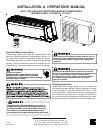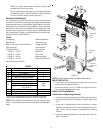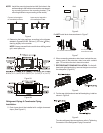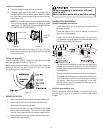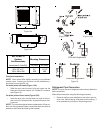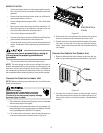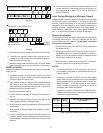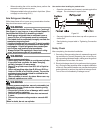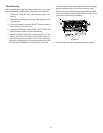
10
• When relocating the unit to another place, perform the
evacuation using a vacuum pump.
• Refrigerant added to the unit must be in liquid form. (Does
not apply to units using R-22.)
Safe Refrigerant Handling
While these items will not cover every conceivable situation,
they should serve as a useful guide.
Refrigerants are heavier than air. They can "push out"
the oxygen in your lungs or in any enclosed space.To
avoid possible difficulty in breathing or death:
•
Never purge refrigerant into an enclosed room or
space. By law, all refrigerants must be reclaimed.
•
If an indoor leak is suspected, throughly ventilate the
area before beginning work.
• Liquid refrigerant can be very cold. To avoid possible
frostbite or blindness, avoid contact and wear gloves
and goggles. If liquid refrigerant does contact your
skin or eyes, seek medical help immediately.
• Always follow EPA regulations. Never burn refrig-
erant, as poisonous gas will be produced.
WARNING
To avoid possible explosion:
•
Never apply flame or steam to a refrigerant cylinder.
If you must heat a cylinder for faster charging,
partially immerse it in warm water.
•
Never fill a cylinder more than 80% full of liquid re-
frigerant.
• Never add anything other than R-22 to an R-22 cy-
linder or R-410A to an R-410A cylinder. The service
equipment used must be listed or certified for the
type of refrigerant used.
• Store cylinders in a cool, dry place. Never use a cy-
linder as a platform or a roller.
WARNING
To avoid possible explosion, use only returnable (not
disposable) service cylinders when removing refrig-
erant from a system.
• Ensure the cylinder is free of damage which could
lead to a leak or explosion.
• Ensure the hydrostatic test date does not exceed
5 years.
• Ensure the pressure rating meets or exceeds 400
lbs.
When in doubt, do not use cylinder.
WARNING
Use caution when handling the packed valve:
• Open the valve stem unit it comes in contact against the
stopper. Do not attempt to open further.
C
D
B
Figure 24
• Securely tighten the valve stem cap with a spanner or
similar tool.
• See tightening torque table in Tightening Connection
section.
Safety Check
After completing the electrical installation:
1. Grounding: After grounding the unit, measure the ground-
ing resistance by visually inspecting the unit and by us-
ing a grounding resistance tester, making sure the ground-
ing resistance is less than 4.0 ohms.
2. Electrical leakage check (to be performed during opera-
tion): During the test operation after complete installation
of the unit, the qualified installer may use the electroprobe
and multimeter to perform the electrical leakage check.
Turn off the unit immediately if leakage occurs.



